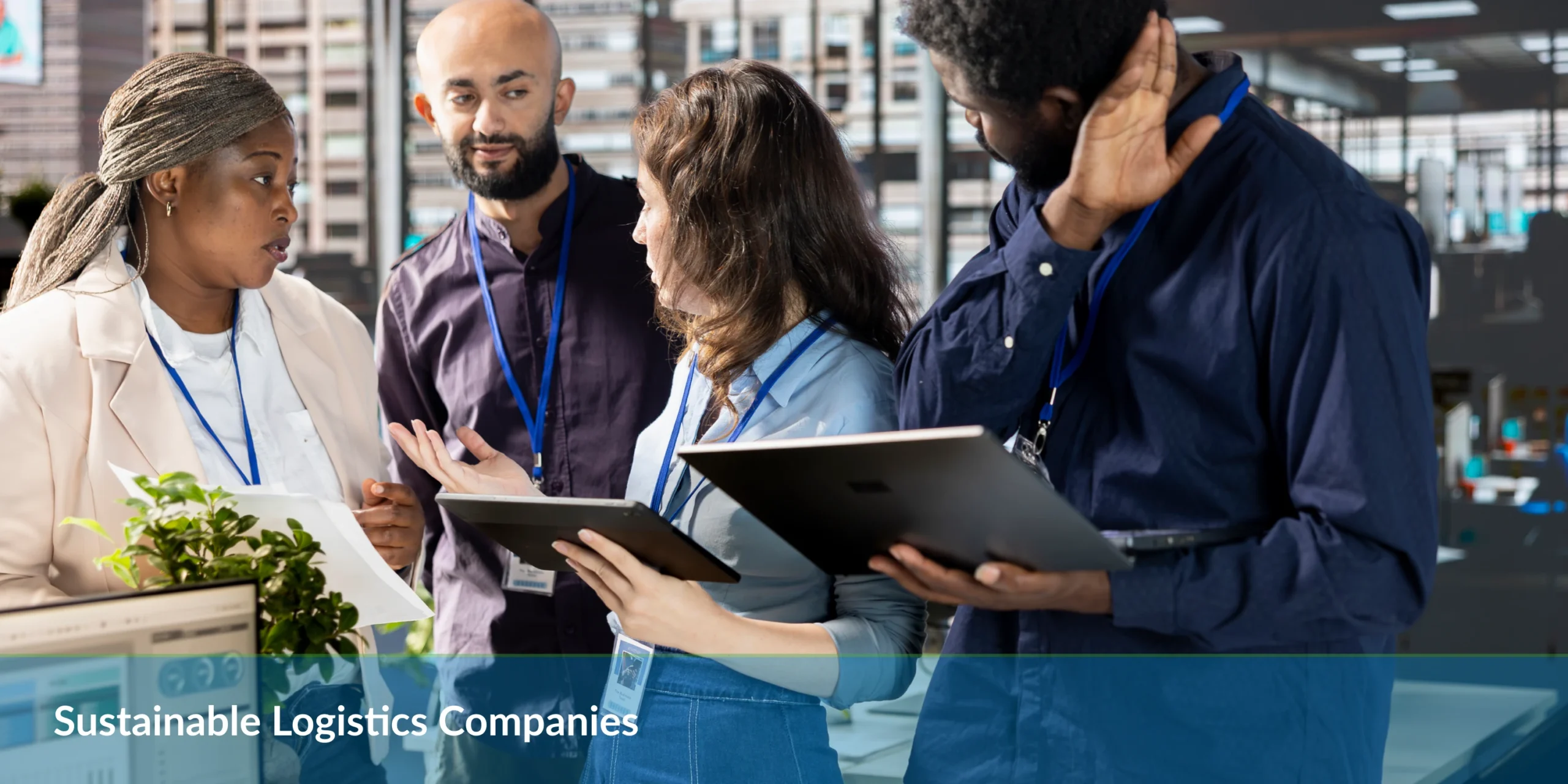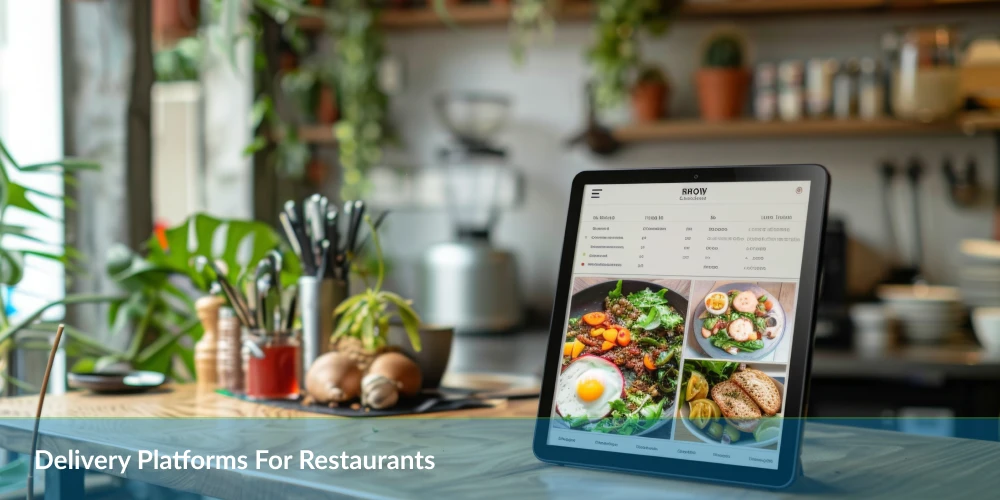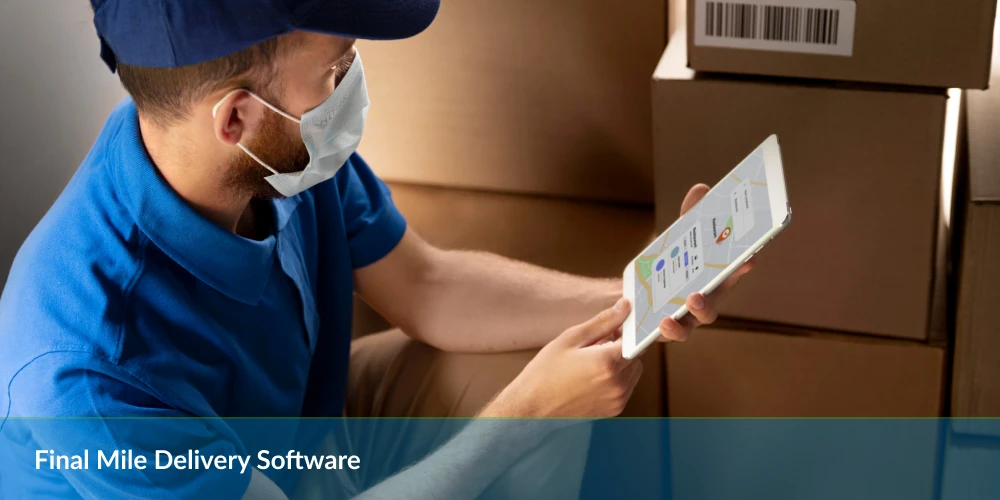Table of Contents
“From 1990 to 2022, carbon emissions from the transport sector rose at an average annual rate of 1.7 percent, making it one of the fastest-growing end-use sectors alongside industry, which saw a similar increase. To meet the goals of the Net Zero Emissions (NZE) by 2050 Scenario, the transport sector must reduce its CO2 emissions by more than 3 percent each year until 2030.”
Source: International Energy Agency
Today, sustainability has shifted from a buzzword to a baseline expectation. Companies across every sector now face mounting pressure to reduce their environmental footprint, and logistics sits at the center of that challenge. From carbon-heavy transportation networks to energy-intensive warehousing, logistics operations contribute a significant share of global greenhouse gas emissions.
Imagine this: a cargo ship gliding across the Atlantic, powered not by fossil fuels but by biofuel or even wind. A fleet of electric trucks delivering goods from port to warehouse without a trace of emissions. Warehouses operate with solar roofs and AI systems that optimize inventory without waste. Just a few years ago, these ideas may have seemed futuristic, but today, they are shaping the very fabric of global trade.
As supply chains grow increasingly complex and consumer demand for fast, affordable delivery intensifies, so does the environmental toll. Freight transport accounts for nearly 8% of global greenhouse gas emissions, and without intervention, that figure is set to rise. In response, companies are rethinking the way goods move around the world. The result? A monumental shift toward sustainable logistics.
But this transition isn’t just about saving the planet; it’s about resilience, innovation, and long-term business viability. As we navigate 2025, sustainable logistics isn’t a trend. It’s a transformation.
What Is Sustainable Logistics?
Sustainable logistics refers to the integration of environmentally and socially responsible practices into the planning, execution, and monitoring of logistics operations. It aims to minimize ecological impact while maintaining or even enhancing the efficiency and profitability of supply chains.
Some of the core elements include:
| Carbon Footprint Reduction | Alternative fuels and electric vehicles should be used to lower emissions. |
| Efficient Route Planning | Leveraging AI and data analytics to optimize delivery routes and reduce fuel use. |
| Eco-Friendly Packaging | Utilizing biodegradable, recyclable, or reusable packaging materials. |
| Green Warehousing | Implementing solar power, energy-efficient lighting, and HVAC systems in warehouses. |
| Reverse Logistics and Recycling | Managing returns and product lifecycles in an environmentally responsible manner. |
Additionally, within freight logistics, trucking dominates. The International Transport Forum (ITF) reported that the road freight share of total international trade-related emissions will grow from 53% in 2010 to 56% by 2050. Whereas Maritime shipping contributes around 11%, while aviation, although responsible for a smaller share of total freight, produces disproportionately high emissions per ton-kilometer.
High-Emission Zones: Transportation, Warehousing, Distribution
GHG emissions emerge at multiple points across a logistics operation. The most significant sources include:
- Truck fleets: Diesel-powered vehicles emit large volumes of CO₂ and nitrogen oxides. Even with efficiency improvements, combustion engines remain carbon intensive.
- Warehouse energy usage: Warehouses rely heavily on heating, cooling, refrigeration, and lighting. Without renewable energy integration, these facilities generate considerable Scope 2 emissions.
- Distribution hubs: Activities like cross-docking, repackaging, and order consolidation require energy and contribute to a logistics company’s overall carbon footprint.
In urban delivery zones, emissions intensify due to traffic congestion and idling. Short-distance, last-mile deliveries can account for up to 50% of a package’s total delivery GHGs, despite representing the shortest leg of the journey.
Best Sustainable Logistics Companies
As environmental concerns take center stage, logistics companies are embracing sustainable practices to reduce their carbon footprint. From electric fleets to green warehousing, these innovators are reshaping the future of global transportation. Here’s a look at the best sustainable logistics companies leading the charge toward eco-friendly operations.
1. NetworkON
NetworkON is a modern logistics management platform focused on last-mile delivery optimization. While it isn’t a traditional logistics carrier, it plays a pivotal role in helping businesses improve delivery efficiency, reduce fuel consumption, and transition toward greener operations through route optimization and automation.
Pros:
- Offers carbon footprint reduction through optimized routing
- Cloud-based, reducing hardware waste
- Enables paperless operations
- Integrates well with electric vehicle fleets
Cons:
- Sustainability depends on the implementation of the business
- Not a direct logistics carrier
- Requires an external fleet to deploy sustainability benefits
2. Amazon
Amazon has made major investments in sustainability, including committing to net-zero carbon by 2040 through The Climate Pledge. It uses electric delivery vans, solar-powered facilities, and AI-based route planning to minimize emissions.
Pros:
- Massive investment in EVs and renewable energy
- Robust supply chain visibility
- Uses AI to improve delivery efficiency
- Climate Pledge commitment gives clear sustainability goals
Cons:
- Complex global operations make full sustainability difficult
- Reports of packaging waste and high emissions from air freight remain concerns
- Heavy energy consumption due to scale
3. DHL Group
DHL has emerged as a leader in sustainable logistics, targeting zero emissions by 2050. They invest in green technologies, electric vehicles, and sustainable packaging across their global network.
Pros:
- Clear sustainability goals and timeline
- Uses electric vehicles and sustainable fuels
- Publishes transparent environmental reports
- Strong global presence with green warehousing
Cons:
- Sustainability progress varies by region
Transitioning a large fleet takes time.
- Green services may be more expensive.e
4. FedEx
FedEx aims for carbon-neutral operations by 2040. Their sustainability efforts include fleet electrification, aircraft modernization, and investments in carbon capture technologies.
Pros:
- Strong investment in electric delivery vans
- Upgrading aircraft to reduce emissions
- Engages in carbon offsetting and sustainable packaging
Cons:
- Air freight still contributes heavily to emissions
- Sustainability progresses more slowly in some operational areas
- A complex logistics network makes total decarbonization a challenge
5. XPO Logistics
XPO Logistics is focused on decarbonizing freight with tech-driven solutions. They integrate electric trucks, energy-efficient facilities, and smart warehousing technologies to lower emissions.
Pros:
- Deploying electric and alternative-fuel trucks
- Tech-enhanced route planning and load optimization
- Committed to carbon reduction through innovation
Cons:
- Sustainability goals are less aggressive than some peers
- Not yet carbon-neutral
- Limited visibility into global emission data
6. Kuehne+Nagel
Kuehne+Nagel has pledged to become carbon-neutral by 2030, with a strong focus on green shipping, carbon tracking tools, and sustainable supply chain solutions for customers.
Pros:
- Provides carbon-neutral sea freight options
- Advanced emission tracking for supply chains
- Offers green logistics consulting for clients
Cons:
- Limited control over third-party emissions
- Complex supply chain makes decarbonization difficult
- Sustainability initiatives are not always visible to end consumers
7. EccoFreight
EccoFreight is a forward-thinking logistics provider specializing in eco-friendly freight solutions. They use carbon footprint analysis and green routing to help businesses reduce their transportation emissions.
Pros:
- Offers specialized sustainable freight solutions
- Expert in carbon emissions analysis
- Strong focus on intermodal transport for lower emissions
Cons:
- Smaller footprint compared to larger logistics companies
- Limited geographic coverage
- Services may be more niche than mainstream
8. IKEA
Though best known as a retailer, IKEA has transformed its supply chain with sustainability at the core. It aims to make all deliveries emission-free by 2025 and uses rail, sea, and EVs for reduced environmental impact.
Pros:
- Aggressive sustainability goals
- Electrified last-mile delivery in many cities
- Strong use of intermodal transport to cut emissions
- Circular economy integration through packaging and materials
Cons:
- Depends on third-party carriers for some operations
- Global scale introduces logistical complexity
- Some regions are still adapting to green logistics practices
Pro Tip: Choose a logistics partner whose sustainability efforts align with your business goals and operational footprint for maximum environmental impact.
What Sets Sustainable Logistics Companies Apart?
Not every logistics company qualifies as sustainable. Only those that embed environmental responsibility across their operations deserve that label. These companies make sustainability a principle, not a marketing gimmick. They’re distinguished by several defining characteristics:
- Transparent reporting systems—robust data tracking on emissions, energy use, and waste delivers accountability.
- Low-emission transportation fleets—strategic investment in electric, hybrid, and alternative fuel vehicles reduces greenhouse gases.
- Green certifications—LEED-certified warehouses and ISO 14001 compliance signal legitimate environmental management systems.
- Supplier collaboration—priority is given to working with vendors who share sustainability aims throughout the supply chain.
Sustainability Embedded Across the Supply Chain
These companies redesign their logistics workflows from the ground up, rejecting cost-cutting practices that undermine ecological responsibility. How? Consider these changes in daily operations:
- Deploying intelligent route optimization software to minimize fuel consumption and idling times.
- Switching to biodegradable or reusable packaging materials cuts down on landfill waste.
- Using environmentally friendly warehouse lighting systems, sensors, and insulation to reduce energy usage.
- Applying reverse logistics models to retrieve, reuse, or recycle returned goods and reduce overproduction.
Integration is non-negotiable. These companies turn sustainability from a secondary initiative into a mode of operation that influences every process, decision, and partnership.
Measurable Value: Why Customers Choose Sustainable Solutions
Customers don’t just get a greener logistics partner—they receive measurable business advantages.
- Enhanced brand reputation: Partnering with a sustainability-focused logistics company strengthens ESG communication and appeals to environmentally conscious consumers.
- Regulatory compliance: Companies operating in the EU and other regulated markets remain compliant through partnerships with green-certified providers.
- Long-term cost savings: Reduced energy consumption, waste minimization, and efficient routing lead to decreased operational expenditure.
What does this mean for your business? Reduced environmental impact, a more resilient logistics chain, and strategic positioning in a world where sustainability shapes both preference and policy.
Role of Carbon Metrics in Sustainable Logistics
Carbon footprint remains the most quantifiable metric to assess environmental impact in logistics. Every shipment, route, and packaging choice contribute to CO₂ outputs. For companies advancing in sustainability, measuring these emissions precisely and consistently is non-negotiable. Accurate carbon accounting informs decisions, drives reductions, and opens the door to impactful sustainability claims that can withstand audit scrutiny and stakeholder evaluation.
Lifecycle Assessments and Performance Metrics
Lifecycle assessments (LCAs) break down emissions across the full value chain, from raw material extraction to last-mile delivery. This approach uncovers unseen emissions, particularly in Scope 3 activities such as outsourced transport and storage Performance metrics based on LCA (Life Cycle Assessment) data, such as CO₂ emissions per kilometer, per ton shipped, or per unit produced, enable businesses to evaluate trade-offs and compare supplier sustainability benchmarks across regions and transportation modes.
- Scope 1: Direct emissions from owned or controlled logistics assets.
- Scope 2: Indirect emissions from purchased electricity powering logistics operations.
- Scope 3: All other indirect emissions, including third-party freight, employee travel, and waste.
By embedding carbon performance into procurement scorecards and operational KPIs, logistics departments shift from reactive compliance to proactive design optimization.
Technology-Driven Emissions Reduction
Digital platforms now track carbon data in real time across intermodal journeys. Internet of Things (IoT) devices, installed on pallets and containers, transmit data on fuel consumption, idle times, and delivery conditions. This granular visibility eliminates guesswork and highlights inefficiencies that directly raise emissions.
Blockchain enhances the integrity of carbon tracking by locking emissions data into immutable ledgers. This aligns multiple stakeholders—shippers, carriers, and regulators—behind verifiable tracking systems. Artificial Intelligence (AI) weaves it all together by predicting emissions outcomes of routing decisions, helping logistics managers choose paths that minimize fuel burn and congestion exposure.
For example, UPS’s ORION system leverages AI and telematics to optimize delivery routes, reducing over 100 million miles annually and saving approximately 10 million gallons of fuel, resulting in direct cuts to both costs and carbon footprint.
Transforming Facilities Through Solar, Wind, and Other Renewables
Logistics companies are making a measurable shift toward renewable energy sources to power their operations. Rooftop solar installations, on-site wind turbines, and power purchase agreements (PPAs) for clean electricity have become standard infrastructure among sustainability-driven providers. In the U.S., companies like DHL and UPS have invested in solar panel systems at key hubs, with the goal of reducing reliance on traditional power grids. For example, the DHL sorting hub in Bonn, Germany, generates over 1,000 MWh annually through its integrated solar array, directly offsetting fossil fuel use and contributing to a lower operational carbon footprint.
Warehouses and Sorting Centers Running on Green Power
Distribution infrastructure creates consistent, high-volume energy demand. By integrating renewables onsite or sourcing green power via energy contracts, logistics hubs can significantly reduce emissions. Amazon reports that as of 2023, 100% of the electricity consumed by Amazon is now matched with renewable energy sources, an increase from 90% in 2022. Facilities across Europe now feature smart energy systems combining solar generation, battery storage, and thermal efficiency upgrades to manage load and optimize energy use throughout the day.
Renewables as a Direct Contributor to Carbon Neutrality Goals
Carbon footprint reduction targets hinge on deep energy transformation. Renewable energy provides a direct pathway to decarbonizing logistics operations. As logistics giants chase carbon neutrality, investment in renewables accelerates. FedEx has committed to carbon-neutral operations by 2040, with a large portion of reductions anchored in renewable electricity use across its facilities and data centers. Emission offsetting through clean energy credits adds reinforcement, but core reductions come from actual renewable generation and consumption at scale.
Key Benefits Driving Business Sustainability
| Lower Long-Term Operational Costs | Solar and wind assets generate energy at zero fuel cost once installed, protecting against fossil fuel price volatility. |
| Improved ESG Performance | Renewable energy usage enhances ESG reports, meeting growing demands for verifiable sustainability metrics from shareholders and clients. |
| Energy Independence | On-site energy generation reduces reliance on grid infrastructure and increases operational resilience. |
| Regulatory Advantage | Early adoption of renewable systems helps businesses stay ahead of changing energy compliance regulations. |
Challenges in Implementing Sustainable Logistics
“As part of the Paris Agreement, the European Union has committed to cutting its greenhouse gas emissions by at least 55% by 2030 compared to 1990 levels, aiming for climate neutrality by 2050”.
Source: The Official European Council Website
Despite significant progress in making logistics more environmentally friendly, the journey toward full sustainability still faces several obstacles. These challenges stem from technological, infrastructural, regulatory, and organizational complexities that impact businesses across all sectors. The role of modern logistics management software in navigating these barriers is growing, but implementation hurdles remain. Below are some of the major hurdles companies encounter when implementing sustainable logistics practices:
1. High Initial Investment
Adopting sustainable logistics often requires a substantial upfront investment. Electric vehicles, renewable energy systems, warehouse automation, and AI-powered tools come with high price tags. While large corporations may have the capital to absorb these costs, small and medium-sized businesses often find it difficult to secure the necessary funding or justify the investment in the short term. Without clear and immediate cost savings, these companies may hesitate to adopt greener alternatives. Financial support, such as subsidies, grants, and low-interest loans, can play a crucial role in making sustainability more accessible.
2. Infrastructure Limitations
The success of sustainable logistics depends heavily on the availability of supporting infrastructure. Unfortunately, the distribution of EV charging stations, smart energy grids, and renewable power sources is uneven across different regions. Urban areas may offer better infrastructure, but rural and underdeveloped regions often lack these facilities. Similarly, digital infrastructure like high-speed internet and IoT networks, which are essential for real-time tracking and smart warehousing, is not always reliable or available. These limitations can hinder the widespread adoption of green logistics practices, particularly for businesses operating in multiple locations.
3. Lack of Standardization
A major roadblock in implementing sustainable logistics is the absence of global standards for emissions reporting, carbon accounting, and sustainability metrics. Different companies use different systems and methods to measure and report their environmental impact, making industry-wide comparisons difficult. This inconsistency reduces transparency and makes it harder for stakeholders to evaluate sustainability efforts. It also creates confusion for businesses trying to comply with environmental regulations across different regions, leading to inefficiencies and additional compliance burdens.
4. Complex Supply Chains
Global supply chains are highly complex, involving numerous stakeholders, transportation modes, and regulatory frameworks. Each entity in the chain may operate under different standards, technologies, and levels of commitment to sustainability. Coordinating efforts across such a diverse network is a significant challenge. It requires aligning goals, streamlining processes, and maintaining visibility across all touchpoints. Advanced logistics management software can support these efforts by improving data visibility and workflow integration across partners. Disruptions caused by events such as geopolitical conflicts, pandemics, or extreme weather can further complicate these efforts and delay progress toward more sustainable practices.
While these challenges are real, they are not impossible to overcome. Businesses that prioritize long-term thinking recognize the value of investing in sustainability. The benefits include cost savings over time, a stronger brand reputation, compliance with evolving regulations, and a positive impact on the environment. Moving forward, collaboration among industries, innovation in technology, and supportive public policies will be critical in overcoming these hurdles and building a more sustainable logistics ecosystem.
Pro Tip: Start small with scalable green initiatives and leverage available grants or incentives to offset initial costs while building momentum toward sustainable logistics.
Partnering with Green-Certified Companies
In today’s interconnected world, no organization operates in isolation. Collaboration across partners and stakeholders plays a key role in shaping sustainable outcomes. By working with environmentally responsible entities, businesses can integrate sustainability into their core operations. This collective effort influences everything from sourcing and packaging to transportation, delivery, and customer experience.
Supply chain sustainability scales when suppliers, logistics providers, and retailers align on environmental goals. A logistics company leveraging SmartWay-certified carriers, for example, cuts Scope 3 emissions—those indirect yet substantial sources that come from business relationships. The value isn’t theoretical. It’s quantifiable, traceable, and regulatory aligned.
Recognized Certifications That Signal Green Commitments
The most credible green collaborations are backed by certifications. These serve as objective indicators of sustainability performance, ensuring that partners adhere to globally recognized environmental management systems.
- ISO 14001: This international standard sets out criteria for an effective Environmental Management System (EMS). Companies certified under ISO 14001 demonstrate continuous improvement in areas such as resource use, waste management, and environmental risk mitigation.
- EPA SmartWay: A U.S. Environmental Protection Agency program that certifies freight transport companies for fuel efficiency and emissions reductions. Partner carriers within SmartWay typically use advanced aerodynamics, idle reduction technologies, and low rolling resistance tires to maximize eco performance.
- LEED Certifications: For warehouse partners, facilities built or retrofitted to meet LEED (Leadership in Energy and Environmental Design) standards addressing energy use, water consumption, and indoor environmental quality.
Proven Collaborations That Deliver Measurable Results
Take the case of a multinational apparel brand that shifted its distribution contract to a SmartWay-certified 3PL. The carrier’s commitment to fleet modernization, combined with advanced routing software, reduced the brand’s annual freight-related CO2 emissions by 18%. Integrating a certified logistics partner didn’t just improve sustainability KPIs—it tightened delivery windows and trimmed fuel costs.
Or consider a chemical manufacturer that onboarded ISO 14001-certified suppliers for its packaging and transportation processes. Over 12 months, its aggregated environmental risks decreased due to tighter controls on hazardous material handling, alongside a 23% drop in landfill waste from packaging changes.
Each of these outcomes began with one decisive action: aligning with certified companies that match the business’s environmental ambitions. These aren’t just partnerships—they’re accelerators of sustainability in motion.
The Future of Sustainable Logistics
As environmental concerns grow and technology advances, the logistics industry is entering a new phase focused on sustainability. The coming years will bring major innovations that aim to lower emissions, improve efficiency, and ensure long-term environmental and economic benefits. Here are some key trends shaping the future of green logistics:
1. Autonomous Electric Freight
Self-driving electric trucks are set to transform freight transportation. These vehicles reduce human error and allow for optimized route planning through artificial intelligence. The result is lower fuel consumption, reduced emissions, and potentially faster, around-the-clock delivery services. With continued development and supportive regulations, autonomous electric freight could soon become a mainstream solution.
2. Green Hydrogen and Biofuels
Electric vehicles are ideal for short-haul trips, but long-distance freight requires alternative energy sources. Green hydrogen and advanced biofuels are gaining attention as practical options. Hydrogen-powered trucks emit only water vapor, while biofuels made from agricultural waste or other renewable materials can significantly cut emissions compared to diesel. These fuels can be integrated into existing logistics operations with fewer changes to infrastructure.
3. Carbon Accounting Platforms
To meet regulatory requirements and sustainability goals, businesses are turning to digital platforms that track and verify carbon emissions across their supply chains. These tools help companies measure their environmental impact more accurately, identify areas for improvement, and stay compliant with international standards. They also support better reporting, making it easier to share sustainability progress with stakeholders and customers.
4. Smart Ports and Eco-Hubs
Modernizing major trade ports is a key step in reducing logistics-related emissions. Smart ports use renewable energy, automation, and AI to manage cargo more efficiently and sustainably. Electric cranes and autonomous vehicles reduce pollution during loading and unloading. These eco-hubs will play a critical role in creating low-emission supply chains and improving the overall flow of goods.
5. Integration with Smart Cities
Urban logistics is evolving in line with smart city developments. By leveraging tools like 5G, real-time traffic data, and centralized delivery zones, logistics providers can reduce congestion and pollution. Electric delivery vans, cargo bikes, and micro-warehouses will become more common in city centers. This approach not only cuts emissions but also improves delivery speed and reliability for businesses and consumers.
Key Takeaways
- Sustainability is Now a Standard, not a Choice
Sustainable logistics has moved from a trend to a necessity, driven by climate change, resource constraints, and consumer demand for greener practices.
- Technology is Enabling Greener Operations
Tools like AI, IoT, blockchain, and carbon accounting platforms are helping logistics companies optimize routes, monitor emissions, and improve transparency.
- High-Impact Areas Include Transport, Warehousing, and Last-Mile Delivery
Truck fleets, energy-hungry warehouses, and last-mile operations are major emission zones that are now being targeted through electrification, renewable energy, and smart logistics.
- Partnering with Certified Green Companies Drives Real Results
Collaborating with ISO 14001, LEED, and EPA SmartWay-certified providers enhances sustainability, improves KPIs, and supports regulatory compliance.
- The Future Lies in Innovation and Integration
Developments like autonomous electric freight, hydrogen fuels, smart ports, and integration with smart cities will define the next era of sustainable logistics.
Wrapping It Up!
As the world grapples with climate change, resource scarcity, and shifting consumer expectations, sustainable logistics has become a linchpin of future-ready trade. This transformation isn’t just about eco-consciousness; it’s about resilience, efficiency, and long-term growth.
By embracing greener practices today, businesses are not only reducing their environmental footprint but also building stronger, smarter supply chains for tomorrow. The future of global trade will be green, and the logistics leaders of tomorrow are the ones investing in sustainability today.
Whether you’re a multinational shipper or a local logistics startup, one thing is clear: sustainability is no longer a luxury. It’s the new standard.
Ready to Future-Proof Your Logistics Operations?
Join the movement toward smarter and greener supply chains with NetworkON. Trusted by sustainable logistics companies, our powerful delivery management platform helps you reduce emissions, optimize routes, and operate more efficiently while meeting the sustainability standards of tomorrow.
Start your sustainable logistics journey with NetworkON today.
Frequently Asked Questions
Q1: What exactly is sustainable logistics?
Sustainable logistics involves integrating environmentally and socially responsible practices into transportation, warehousing, and supply chain operations to reduce ecological impact while improving efficiency.
Q2: Why should businesses invest in sustainable logistics?
Investing in sustainable logistics leads to long-term cost savings, regulatory compliance, enhanced brand reputation, and increased operational resilience.
Q3: What are examples of sustainable logistics practices?
Examples include using electric or hydrogen-powered vehicles, implementing smart route optimization, installing solar panels in warehouses, and switching to eco-friendly packaging.
Q4: How can NetworkON help businesses become more sustainable?
NetworkON helps businesses optimize last-mile deliveries, reduce fuel consumption, enable paperless workflows, and integrate with electric vehicle fleets, making it a valuable tool for sustainable logistics operations.





0 Conversations